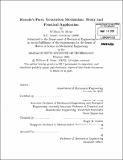Kinesin's force generation mechanism : study and practical application
Author(s)
Hesse, William R. (William Reichard)
DownloadFull printable version (19.62Mb)
Other Contributors
Massachusetts Institute of Technology. Dept. of Mechanical Engineering.
Advisor
Matthew J. Lang and Roger D. Kamm.
Terms of use
Metadata
Show full item recordAbstract
Chimeric kinesin 1 (KHC) / kinesin 5 (Eg5) constructs were used to study the force generation mechanism of the motor protein. The kinesin family of proteins walk along microtubules to carry cargo or pull microtubules along each other and do so by hydrolyzing a single ATP per 8nm step. The mechanism that is employed by kinesin to generate the force necessary for motion is not completely understood. One recent model, the cover neck bundle (CNB) model, utilizes two structural elements of the motor (the coverstrand, which is at the N-terminus of the motorhead) and [beta]9, which is part of the necklinker (C-terminus of the motorhead) to form a beta sheet. The CNB folds toward the motor head and causes the rear, unbound head to travel from behind to in front of the bound motorhead. Recent investigations have shown that the CNB produces enough force to explain single molecule experiments, and that when the CNB is not allowed to form by deletion of the coverstrand, the motor looses the ability to generate force. Recent experiments on dimeric forms of Eg5 (a member of the kinesin 5 family) have shown that the motor is capable of generating nearly analogous amounts of force as kinesin 1, but that it generally dissociates from the microtubule under load rather than coming to a true stall. To investigate the applicability of the CNB model of force generation and to see if a motor with high force capabilities could be generated, these chimeras employed the Eg5 CNB (and in some cases L13), and the rest of the kinesin 1 motorhead. It was found from experiments with a stationary optical trap to measure stall force and the force-velocity relationship of the motors as well as unloaded measurements, such as processivity and velocity, that motors with a matched CNB operated the best, however the use of the Eg5 CNB did not reproduce the force generation capabilities of dimeric Eg5 constructs. These results suggest that perhaps while the CNB mechanism is very important to force generation, it may not be the full explanation. A possible link between the CNB's effect on the rate of the mechanical step of the mechanochemical cycle and the stall force is discussed. This link between mechanical rate and stall force is a potential avenue for rational design of kinesin motors for a specific stall force. Secondly, these results show that the parts of kinesin are not directly interchangeable, and that careful consideration of the interactions between parts must be considered when engineering these motors. A second set of experiments were designed to explore whether the CNB mechanism could be exploited for a rational purpose. The literature consists of many reports of various methods to target kinesin and stop its motility for therapeutic reason. For example, some chemotherapies target kinesin to treat cancer. In this way, an antibody was designed to bind specifically with the coverstrand, thus hopefully disrupting the CNB formation and mechanism of force generation. These experiments demonstrated the the antibody was successful in targeting the coverstrand and in inhibiting kinesin's motion.
Description
Thesis (S.M.)--Massachusetts Institute of Technology, Dept. of Mechanical Engineering, 2011. Cataloged from PDF version of thesis. Includes bibliographical references (p. 72-80).
Date issued
2011Department
Massachusetts Institute of Technology. Department of Mechanical EngineeringPublisher
Massachusetts Institute of Technology
Keywords
Mechanical Engineering.